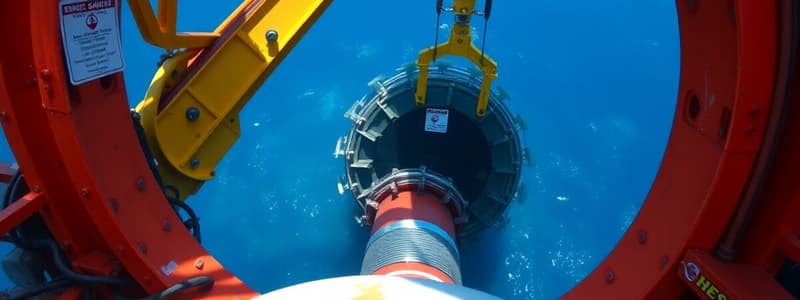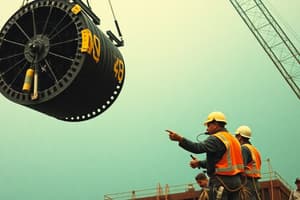Podcast
Questions and Answers
During the subsea spool tie-in operations, what primary factor contributed to the crane hook striking the diver's helmet?
During the subsea spool tie-in operations, what primary factor contributed to the crane hook striking the diver's helmet?
- The crane operator's inexperience with subsea lifting operations.
- Failure to use protective equipment as mandated by safety regulations.
- The diver's failure to follow the approved Job Hazard Analysis (JHA).
- Misinterpretation of the 'no weight' reading, combined with inadequate distance between the crane hook and divers. (correct)
Which action demonstrates effective communication and risk mitigation during subsea operations?
Which action demonstrates effective communication and risk mitigation during subsea operations?
- Reinforcing clear communication between the dive supervisor, crane operator, and divers regarding equipment location and challenging assumptions about equipment positioning. (correct)
- The diving supervisor directs the diver to disconnect rigging without confirming the crane hook's precise location.
- A crane operator assumes the hook is on the seabed based on a 'no weight' reading and proceeds without verifying with the diving supervisor.
- Relying solely on pre-operation inspections without ongoing monitoring of equipment during critical phases.
According to the safety flash, what is a key measure to prevent crane hook incidents during subsea operations with limited visibility?
According to the safety flash, what is a key measure to prevent crane hook incidents during subsea operations with limited visibility?
- Increasing the speed of the lifting operation to reduce exposure time.
- Using longer crane wires to increase the working radius.
- Implementing alternative methods such as underwater cameras or sonar to improve the tracking of critical equipment. (correct)
- Relying solely on the diver's experience to navigate in poor visibility.
Following the incident, an IMCA member updated project procedures. Which update would most effectively address the root cause of the incident?
Following the incident, an IMCA member updated project procedures. Which update would most effectively address the root cause of the incident?
In the context of subsea operations, what does the phrase "challenge assumptions" primarily refer to?
In the context of subsea operations, what does the phrase "challenge assumptions" primarily refer to?
Flashcards
Subsea Crane Hook Incident
Subsea Crane Hook Incident
Unexpected crane hook strike of diver's helmet during subsea spool tie-in operations due to poor visibility and misjudged equipment position.
Causes of the Incident
Causes of the Incident
Inadequate crane pennant length and poor visibility hindered accurate observation of crane hook position, combined with assumptions about equipment position, led to the incident.
Preventative Actions
Preventative Actions
Ensure sufficient distance between divers/crane hook, use visibility aids, reinforce communications, minimize assumptions regarding equipment position.
Member Actions
Member Actions
Signup and view all the flashcards
Positive outcome due to PPE
Positive outcome due to PPE
Signup and view all the flashcards
Study Notes
- During subsea spool tie-in operations, a crane hook struck a diver's helmet
- The incident occurred during subsea spool tie-in operations in poor visibility
What Happened
- Divers were working on the seabed when the incident occurred
- After landing the pipe handling frame (PHF) on the seabed, the Diving Supervisor ordered the crane operator to lower the crane hook to allow the diver to disconnect rigging
- The crane operator reported 'no weight' on the crane wire
- The Diving Supervisor assumed the hook had reached the seabed
- The diver began disconnecting the PHF from the crane
- The diver was positioned beneath the PHF
- While the diver was disconnecting the rigging, the crane hook struck the diver's helmet
- The diver was unharmed and returned to the dive bell
- The reclaim helmet was damaged beyond repair, including the side block
- The helmet's integrity was maintained, demonstrating quality and durability
- The diver was unharmed
What Went Right
- Diver 2 assisted Diver 1, ensuring no injuries occurred
- Both divers immediately returned to the bell safely
- Both divers and the crane block had locating beacons for accurate tracking
- Procedures, lifting plans, and Job Hazard Analysis (JHAs) were followed
- Protective equipment absorbed the impact
What Went Wrong
- When lowered for PHF rigging disconnection, the crane hook rested on the top beam of the PHF
- This resulted in a 'no weight' reading
- The crane operator assumed that the hook had reached the seabed
- As the diver approached the disconnection point, the hook slipped off the beam
- The hook struck struck the side of the diver's helmet
Cause
- Inadequate length of crane pennant/stinger did not provide sufficient distance between the divers and crane hook
- Poor visibility hindered the ability to observe the crane hook's position
Lessons and Actions
- Ensure adequate distance between divers and crane hook
- Maintain a safe distance between divers and the crane hook during subsea operations to reduce the risk of accidental contact, especially in limited visibility
- Use enhanced visibility aids and monitoring
- In poor visibility, use underwater cameras, sonar, or additional locating beacons to track the position of critical equipment like the crane hook
- Improved monitoring can prevent misjudgments about equipment location
- Reinforce communications and challenge assumptions
- Minimize assumptions regarding equipment position
- Reinforce clear communication and confirmation procedures between the dive supervisor, crane operator, and divers to ensure awareness of the equipment's location
Actions Taken
- Updated project procedures to specify minimum pennant lengths for different operations
- Conducted pre-operation inspections of all rigging and lifting equipment, including crane hooks and pennants
- Updated the Job Hazard Analysis (JHA) to incorporate lessons learned from the incident
- The updated JHA includes information regarding safe distances, visibility, and communication requirements for subsea lifting operations
Studying That Suits You
Use AI to generate personalized quizzes and flashcards to suit your learning preferences.




